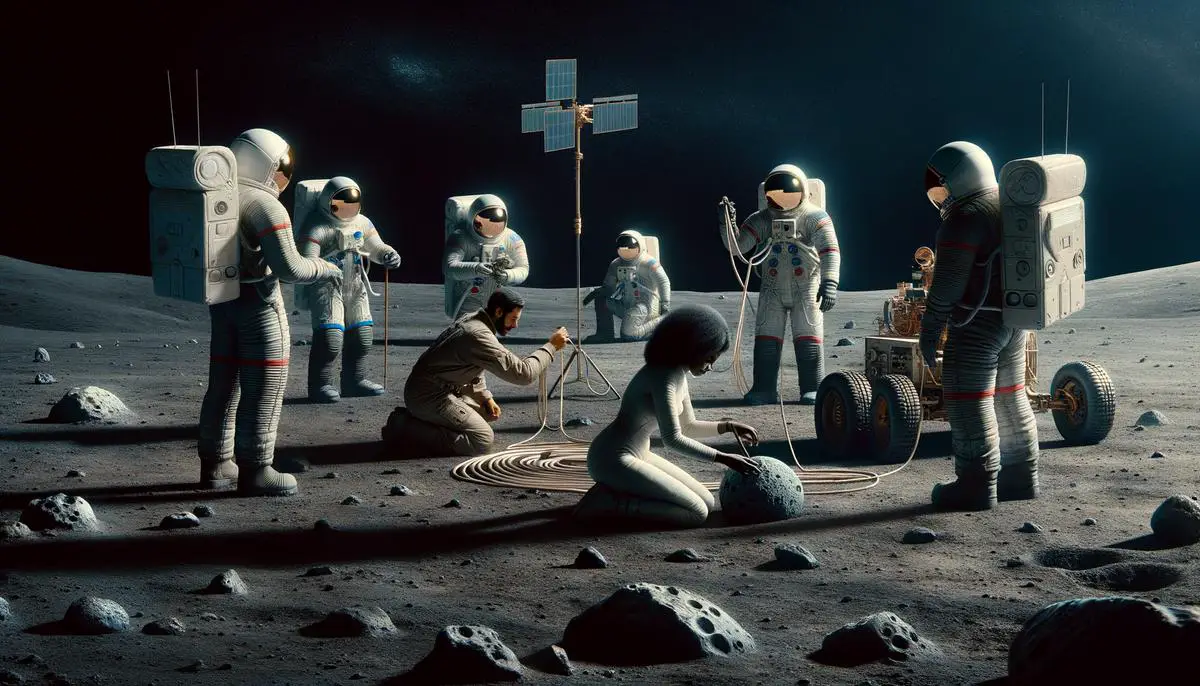The Apollo missions, a series of spaceflights conducted by NASA in the late 20th century, represented humanity’s initial steps on the moon, igniting a curiosity about our lunar neighbor that persists to this day. The Artemis Program, drawing upon the legacy of Apollo, aims to return humans to the moon and establish a sustainable presence there. This endeavor is not just about revisiting an old destination but about advancing human presence in space for future generations. The journey from Apollo to Artemis encapsulates a transition from pioneering explorations to establishing a foothold for humanity in space, highlighting the evolution of space technology and international collaboration.
Contents
Historical Context of Human Lunar Landings
The Apollo missions of the 1960s and 1970s marked humanity’s first steps on the lunar surface, leaving behind footprints and an insatiable curiosity about our closest celestial neighbor. The experiences and scientific data gathered from these pioneering missions have become the bedrock upon which the Artemis Program stands. The Artemis Program aims to return humans to the Moon and establish a sustainable presence by the end of this decade, propelling our exploratory spirit forward.
One of the most significant contributions of the Apollo missions to the Artemis Program is in the realm of human spaceflight technologies. The challenges of sending astronauts to the Moon, ensuring their safety, and returning them to Earth fostered developments in rocketry, spacecraft design, life support systems, and spacesuits. For the Artemis Program, engineers have learned from past technologies and are refining them, like developing the Space Launch System (SLS) which draws on the power and design principles of the Saturn V rockets.
Additionally, Apollo missions’ geochemical analyses of Moon rock and soil samples have directly influenced the scientific objectives of Artemis. Understanding the Moon’s composition has opened avenues for researching how the Moon’s resources could support long-term human presence. The discovery of water ice in permanently shadowed lunar craters by subsequent missions further fueled ambitions for in-situ resource utilization strategies that are pivotal for the Artemis Program’s goals.
Navigation and living on the lunar surface posed unique challenges during the Apollo era, guiding current plans for Artemis habitats and mobility solutions. The Apollo experiences underscored the importance of protecting astronauts from the Moon’s harsh environment, characterized by extreme temperatures, micrometeoroid impacts, and potentially harmful lunar dust. These insights have led to design considerations for Artemis habitats that shield astronauts and technology from these elements.
Moreover, Apollo’s mission architectures have informed Artemis’s strategy of using a lunar Gateway—a space station in orbit around the Moon—that serves as a staging point for lunar landings. This approach builds on the Apollo missions’ concept of a command module remaining in lunar orbit while a lunar module descended to the Moon’s surface. The Gateway enables more flexibility for landings on different parts of the Moon and supports a sustained human presence.
Crucially, Apollo taught the value of international collaboration and the sharing of scientific knowledge gained from lunar exploration. Artemis has expanded on this legacy by fostering partnerships with space agencies around the world, emphasizing cooperative objectives for lunar exploration, scientific discovery, and technology sharing through the Artemis Accords.
Reflecting on lessons from surviving technical and logistical challenges during Apollo missions has paved the way for innovations in robot-assisted construction techniques that are essential for building Artemis’s Lunar Base Camp. The ability to remotely operate vehicles and construction machinery on the lunar surface is a direct descendant of the remote-control technology used in the Apollo
Lunar Roving Vehicles.
By drawing upon the Apollo program’s rich heritage of exploration, achievements, and challenges overcome, the Artemis Program stands on the shoulders of giants. It strives not just to repeat historical feats but to expand human presence to the Moon and beyond, preparing us for the next giant leap in our exploration of space.
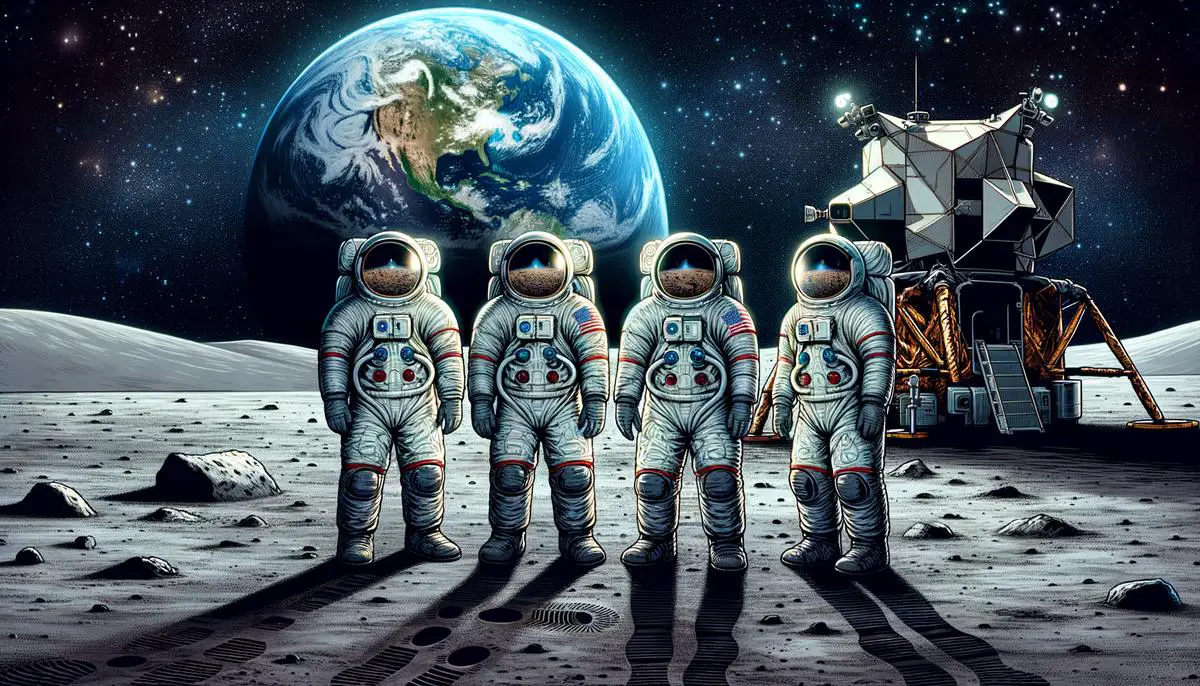
Overview of the Artemis Program
The Artemis Program, named after Apollo’s twin sister in Greek mythology, signifies a new era of lunar exploration. Central to its mission is sending astronauts to the Moon’s South Pole, a region never before explored by humans. This ambitious goal is not just for the sake of exploration but to conduct groundbreaking scientific research that could redefine our understanding of the Moon and broader cosmos.
At the heart of Artemis’s objectives is the ground-breaking plan to make history by landing the first woman and the next man on the lunar surface. This isn’t just a significant milestone for astronaut diversity; it paves the way for a future where space exploration is inclusive, offering unique perspectives that enrich scientific inquiry and discovery.
Artemis’s phases are carefully structured, each building upon the achievements and learning of its predecessors. Artemis I, an uncrewed mission, aims to test the powerful Space Launch System (SLS) and the Orion spacecraft – the vehicles designed to carry astronauts further into space than ever before. Next, Artemis II will see a crewed spacecraft orbiting the Moon, setting the stage for the subsequent lunar landing attempt of Artemis III. This phased approach ensures that each mission advances NASA’s capabilities in human deep space exploration.
Looking beyond the immediate thrill of returning astronauts to the Moon, Artemis harbors a vision for a sustained human presence on lunar soil. By leveraging innovative technologies and international collaboration, NASA aims to establish a base camp on the Moon. From this outpost, astronauts can conduct longer and more in-depth scientific research, testing new technologies that will be crucial for the next giant leap: human exploration of Mars.
Moreover, Artemis emphasizes the crucial role of commercial partnerships in achieving its objectives. By engaging private companies to deliver payloads and service modules to the Moon, NASA is fostering a new lunar economy. This not only accelerates the program’s ambitions but also opens up new avenues for scientific and commercial ventures on the Moon.
In essence, Artemis isn’t just about ticking boxes or revisiting past glories. It’s about laying down a sustainable framework for future space exploration, where humans will live and work on other celestial bodies. The knowledge gained and the technologies developed during this journey could revolutionize how we conceive space travel, heralding a new age of discovery and opportunity across the cosmos.
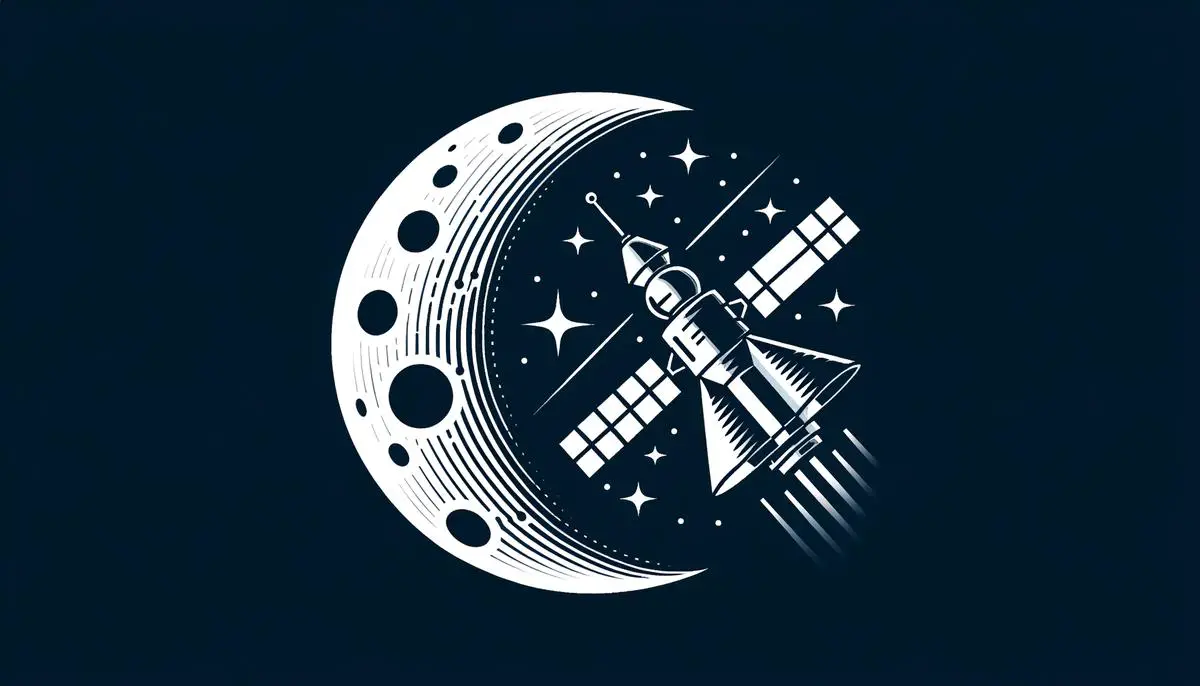
Technological Innovations and Challenges
The Space Launch System (SLS) represents a leap in propulsion technology, designed to be more powerful than any rocket ever built. It can carry astronauts and cargo to the moon faster, marking a significant step forward in reducing travel time and exposure to space radiation, which is a critical concern for astronaut safety during lunar missions.
Orion spacecraft, the vessel that will ferry humans into lunar orbit, incorporates advanced life support systems that are pivotal for long-duration missions. These systems ensure that astronauts have adequate air, water, and temperature control to survive the journey to and from the moon. Orion’s heat shield, designed to withstand the extreme temperatures of re-entering Earth’s atmosphere, represents state-of-the-art material science.
- The lunar Gateway, an outpost orbiting the moon, plays a crucial role in reducing the complexity and cost of lunar missions. It serves as a multifunctional station where astronauts can live, conduct research, and dock vessels for missions to the lunar surface or deeper into space. The Gateway is instrumental in addressing logistical challenges of establishing a sustainable lunar presence by acting as a pit stop for astronauts and equipment.
For landing on and returning from the Moon’s surface, new human landing systems are in the works. These landers are being designed to touch down on more challenging terrains, such as the rugged South Pole region, which has never been explored by humans. This involves creating landing technology that can operate in the moon’s weaker gravity and deal with its dust, which poses a risk to both astronauts and equipment by sticking to and potentially clogging or abrading spacesuits and machinery.
- Building on the Artemis program, technologies for utilizing in-situ resources, like extracting water ice from the Moon to produce drinking water or oxygen, are crucial for long-term human survival and reducing the need to transport resources from Earth. This approach aims at tackling the challenge of resource limitation by turning the Moon into a refueling station for further explorations.
Additionally, communication and navigation systems specifically~ tailored for the lunar environment are being developed. These technologies are critical for ensuring that astronauts can navigate the lunar terrain safely, maintain communication with Earth, and conduct scientific research efficiently. The tools combine innovations from terrestrial and satellite technology but are adapted to work in the extreme conditions of space and the moon’s surface.
Power generation and storage face unique challenges on the Moon due to the long lunar night. Solar power technologies, along with nuclear power options, are being explored to ensure a constant and reliable energy supply for lunar bases, which is integral for both survival and conducting ongoing scientific experiments.The Artemis Program isn’t just leapfrogging back to the Moon; it’s bringing together a synergy of new technologies aimed at overcoming the barriers of space exploration. The steps being taken address everything from the ride out of our atmosphere to ensuring astronauts can safely live and work on the Moon, laying down the groundwork for the future where the Moon serves as a stepping stone for missions farther into our solar system.
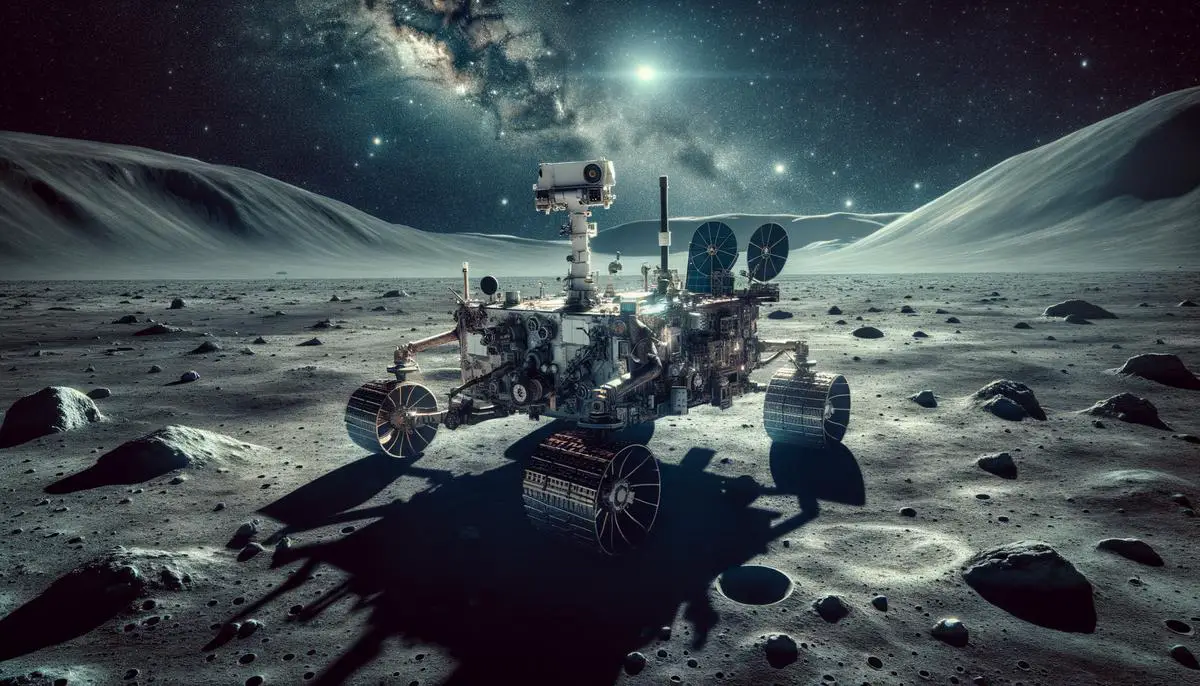
Scientific Objectives and Research Opportunities
Understanding the Moon’s geography and the mysteries beneath offers a fresh frontier in lunar exploration. The Artemis Program aims to peel back the layers of the Moon’s surface, probing into its interior structure. By sending sophisticated instruments to the lunar surface, scientists hope to map its inner geology, uncovering details about the Moon’s formation and its tectonic activity. This exploration might reveal the secrets hidden in the Moon’s mysterious craters and rugged terrain, offering clues to the early solar system’s history.
Another critical aim of the Artemis Program is the search for water ice in permanently shadowed regions of the Moon’s poles. This ice is not just a potential source of drinking water for future astronauts but also a valuable resource that could be converted into oxygen and rocket fuel. Identifying and accessing these water ice deposits would be monumental for the sustainability of long-duration lunar missions and could pave the way for human exploration of Mars and beyond.
The Moon also serves as an ideal testing ground for new technologies crucial for more ambitious space exploration missions. Technologies such as precision landing systems, advanced space suits, and new methods for generating power and surviving in harsh environments will be vetted on the lunar surface. These technologies are critical for ensuring the safety and well-being of astronauts, making the Moon a crucial step in preparing for human missions to Mars.
Moreover, conducting science on the Moon provides an unparalleled opportunity to study cosmic phenomena from a unique vantage point. The Artemis astronauts will install new scientific instruments that can monitor cosmic rays, study the Sun’s interaction with the lunar surface, and peer deeper into the universe without the Earth’s atmospheric interference. These studies could uncover new insights about the universe’s formation, offering a broader understanding of our place within it.
Lastly, the satellite missions accompanying Artemis aim to map the lunar surface in unprecedented detail, monitoring its weather patterns, potential seismic activities, and geological changes over time. This data will not only aid in astronauts’ safety but also in understanding how celestial bodies evolve and sustain life-supporting environments. Through these combined efforts, the Artemis Program is setting the stage for a new era of lunar science and exploration, bridging the gap between humanity and the cosmos.
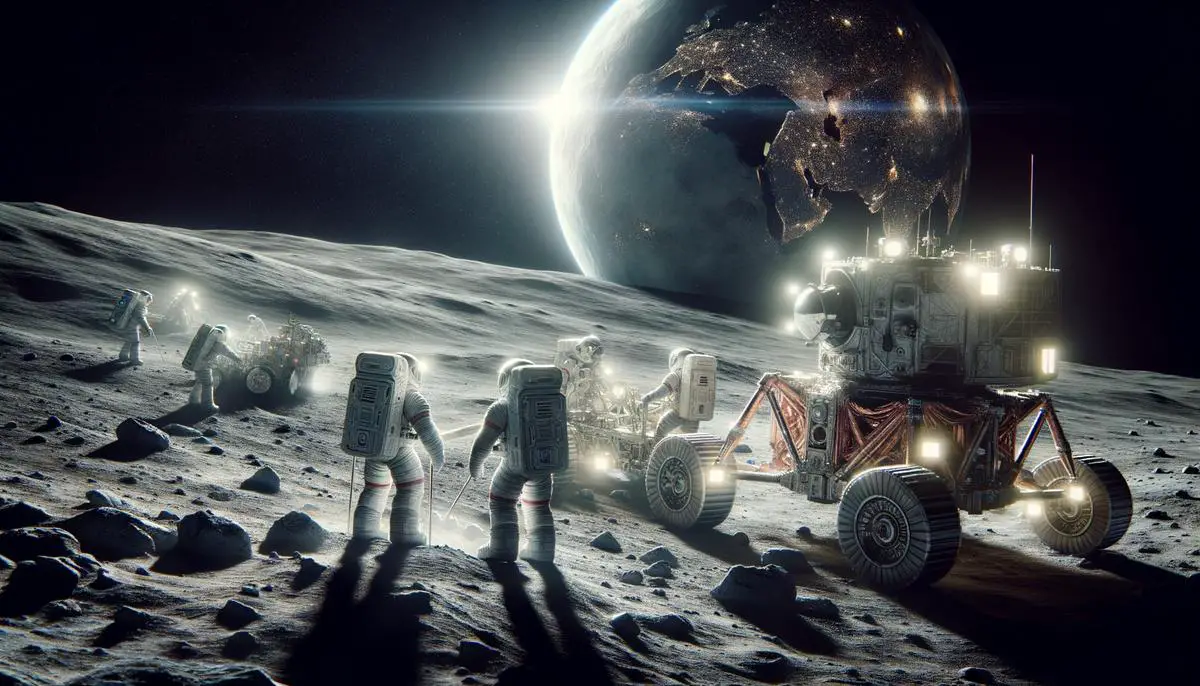
International Collaboration and Commercial Partnerships
The Artemis Program elevates the role of international and commercial partners to unprecedented heights, creating a collaborative space exploration model. Forging partnerships with agencies like the European Space Agency (ESA), the Canadian Space Agency (CSA), and the Japan Aerospace Exploration Agency (JAXA) pools a vast reservoir of technological expertise, financial resources, and innovative research. These global partnerships are instrumental in developing critical components such as the European Service Module, which powers and propels the Orion spacecraft, and CANADARM3, a highly sophisticated robotic arm by CSA for the lunar Gateway.
Commercial entities also play a pivotal role by providing logistical and technological support that diversifies and strengthens the program’s foundation. Companies like SpaceX and Blue Origin are developing human landing systems (HLS) to transport astronauts from lunar orbit to the Moon’s surface and back. This competitive environment stimulates technological advancements, making lunar travel more affordable and technically viable.
Furthermore, these partnerships introduce a barter system, where instead of financial transactions, contributions are made in the form of hardware, services, or expertise. This arrangement broadens participation without necessitating direct investment, making the Artemis Program a truly global venture. For instance, ESA’s contribution of the service module is crucial for the Orion spacecraft’s missions, illustrating how resource-sharing can facilitate complex space explorations.
Another critical aspect of these partnerships is the sharing of scientific data and research findings. By allowing wide access to lunar data collected during Artemis missions, NASA aims to foster a global scientific community focused on lunar exploration. This pursuit not only advances our understanding of the Moon but also solidifies international cooperation in space exploration, setting a precedent for future missions to Mars and beyond.
The commercial and international partnerships within the Artemis Program also emphasize sustainability. Through collaborative efforts in creating reusable space exploration technologies, such as SpaceX’s reusable rockets, the program aims at ensuring that space exploration is sustainable both environmentally and economically. This strategic approach enables a constant presence on the Moon, facilitating long-term research and exploration goals.
Moreover, these collaborations are catalysts for the development of new industries within the burgeoning space economy — from space tourism to lunar mining. The involvement of commercial entities paves the way for innovative business models and opportunities far beyond traditional aerospace domains.
In conclusion, the synergy between international space agencies and commercial partners through the Artemis Program demonstrates a dynamic shift towards a cooperative model of space exploration. By tapping into the collective pool of global resources, expertise, and innovative spirits, the Artemis Program is not just charting a course back to the Moon but is also laying down the foundation for the future of international space exploration.

In essence, the Artemis Program embodies the collective aspiration of humanity to advance our presence in space, building on the foundation laid by the Apollo missions. It is a testament to human ingenuity and the spirit of cooperation that transcends borders. By focusing on sustainable lunar exploration and fostering partnerships across the globe, Artemis is not just revisiting the moon but is paving the way for future generations to live and work beyond Earth. This program stands as a beacon of progress, symbolizing our ongoing quest to expand human horizons and deepen our understanding of the cosmos.
